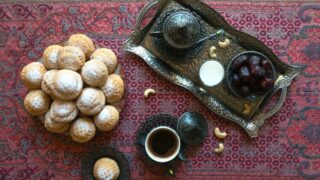Muslims in America and the Western World all know the scent of Christmas. As they walk through the malls, streets and stores each December, the scent of gingerbread, pine needles and cinnamon waft through the air. Even Muslims who don’t live in America probably gaze at the news coverage and wonder – why is everyone so excited? And as Muslims, we wonder – how can we get our children to be that excited about Eid? Christmas is a “hard act to follow”. However, Muslims can create an atmosphere of Eid that will capture the hearts and joy of the children – even in the midst of Christmas trees and Santa’s sleigh. It’s all a matter of science.
Studies show that using all our senses is the best way to absorb information and become completely involved in an event. A holiday must embrace all the senses of a person – heart, imagination, soul, sight, hearing, taste, the sense of smell and the sense of touch. Children are conditioned to find joy and excitement every Christmas because they are conditioned to love the holiday with all their senses. They sing Christmas songs with their voices, they listen to stories of Santa with their imagination, they pray with their hearts, they taste cookies with their mouths, they hear carols with their ears, they feel pine needles with their hands and they smell gingerbread and cinnamon with their noses and they see houses decorated with lights on every street corner. Using science you can create that same feeling in your children during `Eid.
The sense of smell is the most important sense to consider when celebrating. There is a very strong connection between smell and memory. Aroma processing is wired directly into the limbic system where memory is stored and emotion resides. In fact the sense of smell is so powerful that it is being employed to speed learning in some schools (Aoyama p. 2). Looking back in history, we can see the sense of smell being used in almost every culture and in different religions as well. The Greek Orthodox Church has a philosophy of incorporating all five senses into their service. Incense is burned to appeal to the sense of smell. In Judaism, a spice box is used in the Havdalah service, which is held at the end of the Sabbath, to start the new week afresh. Pungent and pleasant spices such as cinnamon, cloves, and cardamom are usually used (Ayoma, p. 3).
The Boston Globe reported that within the same culture, people of different generations experience nostalgic feelings triggered by different odors. Those people born in the 1920’s, 30’s, and 40’s have these feelings when smelling flowers, sea air, cut grass and burning leaves, but those born in the 50’s, 60’s and 70’s became nostalgic when smelling Play-Doh, window cleaner, hair spray, suntan lotion and felt-tip pens (Klein, 1995). In the same way, Muslims want their children to feel more nostalgic about the smells of `Eid than they do about the smells of Christmas or other Western holidays.
One thing that already smells wonderful during Eid is the Eid Breakfast. However, when creating a strong event oriented memory one needs to create a regular sensation of smell related to that event. For this reason Muslims should try to prepare very savory and pungent dishes during `Eid which use a variety of aromatic spices such as cinnamon, cloves, cardamom, curry or cumin.
The smells of cooking should also be supplemented with pleasant smells in the atmosphere. One can chose to use essential oils or incense, but the smell should be special and associated with Eid time. A person can use essential oils typically used in spiritual celebrations of the Muslim world such as rose oil or sandalwood. Alternatively, one can mix a personal oil combination to create a personal perfume for Eid time or to create a special room scent for the `Eid Holiday. One such combination could be that of sandalwood, neroli and patchouli. Another idea is to combine geranium and rose or to combine rose and ylang ylang. Bergamot with a touch of lemon or tangerine is perfect to create a celebratory mood. These scent combinations could be used as incense or as perfume.
Of course the sense of smell often goes hand in hand with the sense of taste. In fact, the sense of taste is one that the Eid Breakfast is famous for. However, taste buds wear out every week to ten days and we replace them, although not as frequently over the age of forty-five. Our sense of taste is not as sharp as we get older (USOE, p. 3). So most of the memories of taste will probably still be retained in the sense of smell category. However, one can still capitalize on this sensation by creating some special “Eid Dishes” such as Eid cookies or Eid cakes.
The sense of sight is another important sense. Seventy percent of the body’s sense receptors cluster in the eyes, and it is mainly through seeing the world that we appraise and understand it (USOE, p.1). Seeing everyone dressed in new clothes is a pleasure for the sight. However, as Muslims living in the casually-dressed West the community sometimes downplays the significance of fancy Eid clothes and buy the kids some new jeans for Eid or a new T-shirt. Instead, Western Muslims should buy their children something rich and colorful and joyful to look and not something casual.
The sense of sight is another important sense. Seventy percent of the body’s sense receptors cluster in the eyes, and it is mainly through seeing the world that we appraise and understand it (USOE, p.1). Seeing everyone dressed in new clothes is a pleasure for the sight. However, as Muslims living in the casually-dressed West the community sometimes downplays the significance of fancy Eid clothes and buy the kids some new jeans for Eid or a new T-shirt. Instead, Western Muslims should buy their children something rich and colorful and joyful to look and not something casual.
The sense of touch is a hard one to capture. However, it is perhaps the second most important after the sense of smell. This is because the skin is the largest organ of the body and weighs about six to ten pounds. Furthermore, studies have shown that touch plays a crucial role in child development. Touch is the key to our survival and perhaps the survival of Eid in the west. (Akerman) Muslims can encourage their children to experience the sense of touch during Eid by buying them Eid clothes made of soft velvet or silky material or Eid gifts they can hug such as a stuffed animal or soft doll. Children should be given extra hugs on Eid and encouraged to enjoy the sensation of the soft prayer mats as they pray and the carpet on the floor of the mosque. Creating Eid traditions can encourage other memories of touch. A “Celebration Table” for Eid can be made by setting selected objects on a table covered with silk or cloth. Included on the table can be cool and metallic coins, soft plush animals, crispy rice, and cottony tufts of “snow” or crackly bits of fall leaves according to which season Eid has fallen in. Children should be encouraged to feel the objects they have chosen and add as many objects as they wish to the table.
Last, but not the least are the senses of the heart and the sense of imagination. Children should be told many stories during Eid. Stories about what Eid was like for their parents or what Eid is like in other countries can be part of their Eid day. There are some storybooks about Eid, however, the best stories will be created on an individual basis. Stories can come in the form of puppet shows, felt-board stories, plays, songs or tales about Eid. Children should be told Eid stories every night and encouraged to create plays and puppet shows about Eid during the day.
By Karima Burns, MH, ND
Sources:
Ackermann Aoyam, Sara. “The Role of the Sense of Smell in Language Learning.” School for International Training. 1999.
Ackerman, D. (1991). “A Natural History of the Senses.” NY: Random House.
Klein, Richard. “Get a Whiff of This: Breaking the Smell Barrier” The New Republic, February 1995. 18-23
USOE. “The Five Senses Lesson.” Utah State Office of Education. 1997.


















